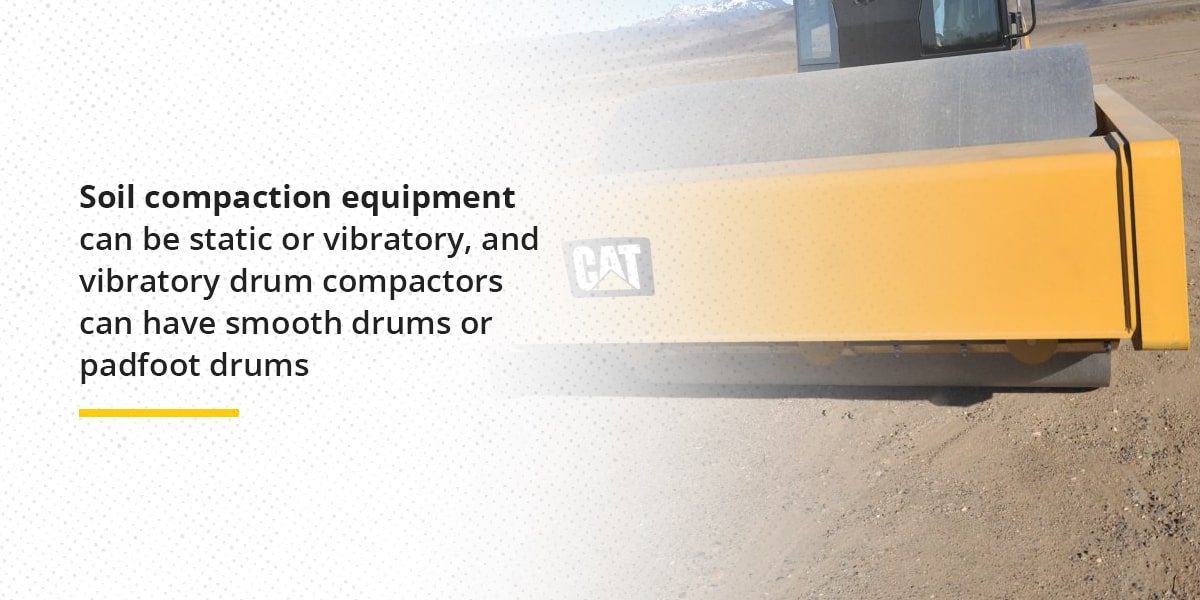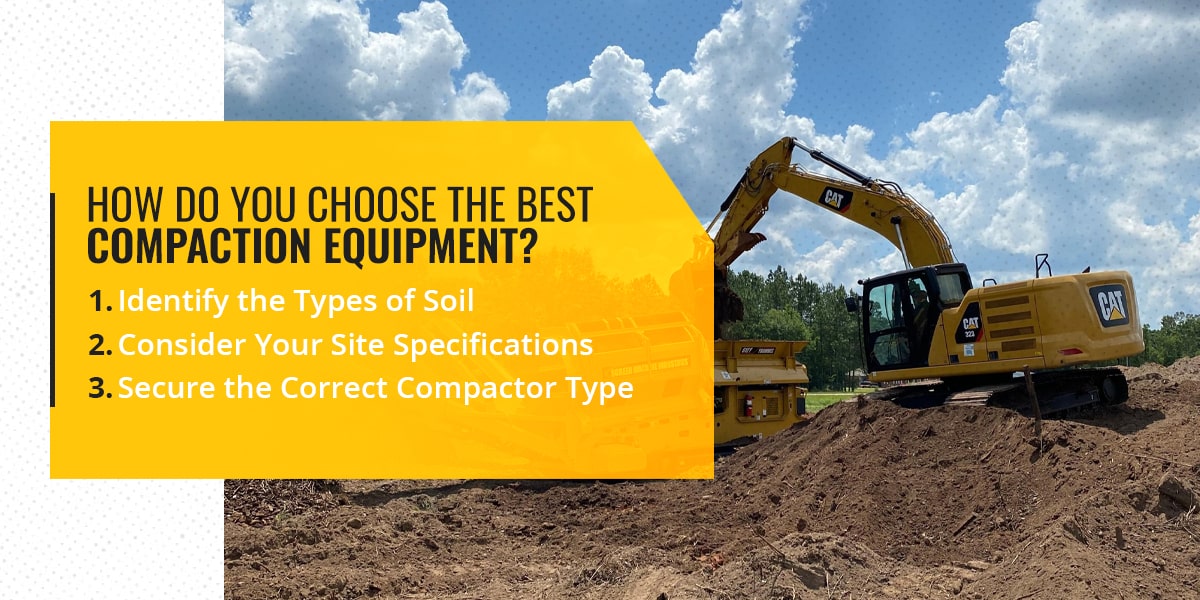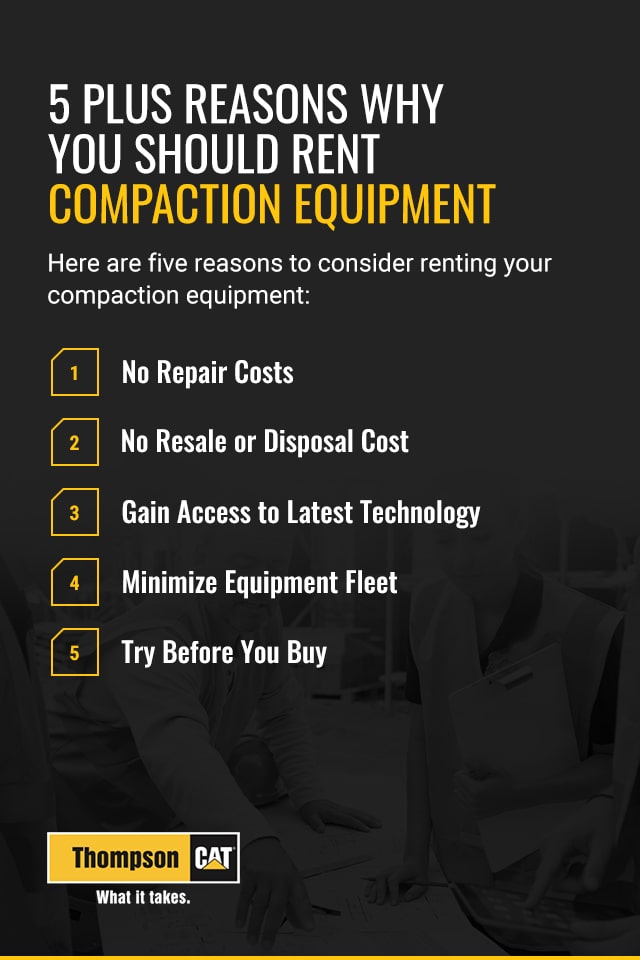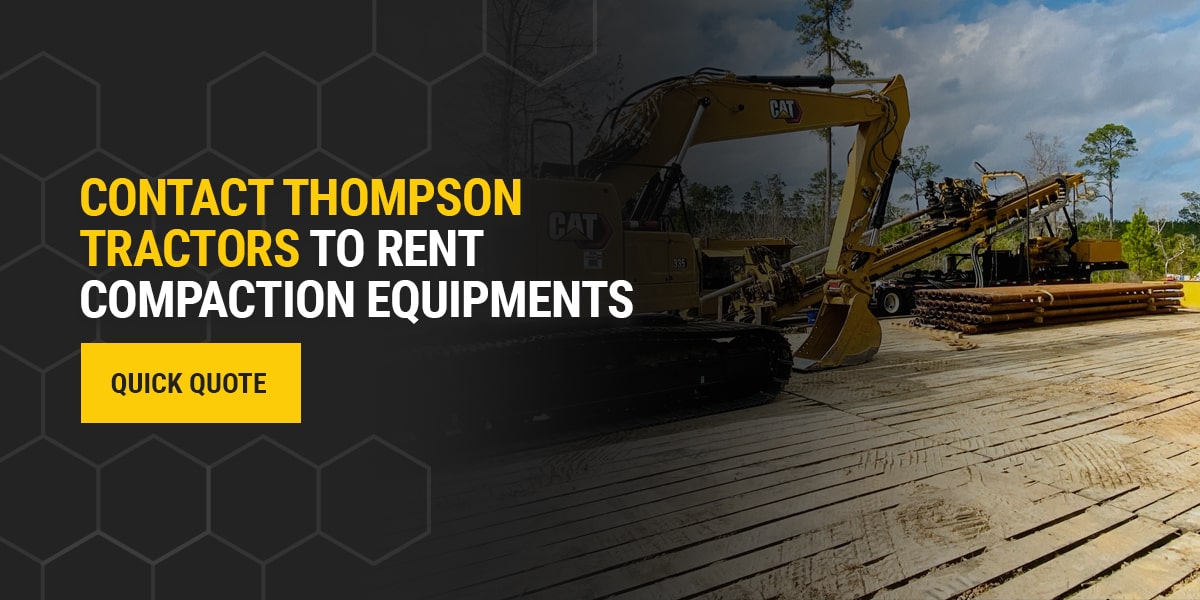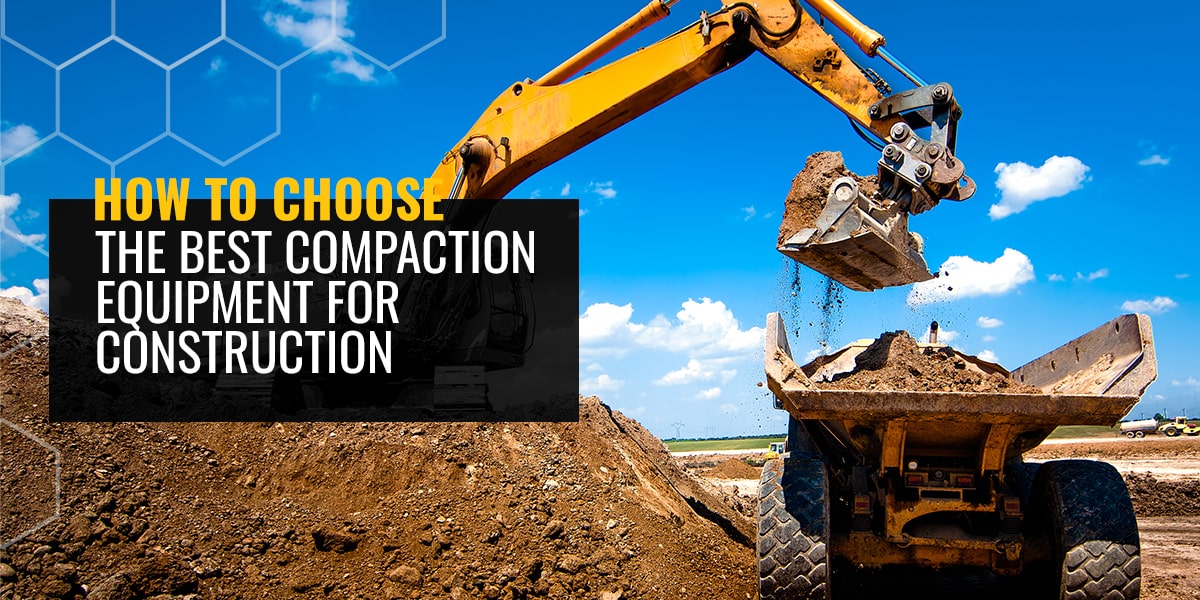
Soil compaction takes place in almost every construction project. Construction crews use compaction equipment to increase soil density by reducing the spaces between or the amount of air within the soil particles. The process is helpful for all soil types.
Compacted soil has a higher unit weight. It provides the flat surface necessary for the support, stability, and resistance that buildings, pavements, roads, construction foundations, and other structures need. It also increases bearing capacity and decreases frost damage and permeability. In essence, soil compaction prevents walls, pipes, and roads from cracks and damage. It also fixes uneven floors or surfaces.
The soil compaction equipment you choose depends on the type of construction activity. When selecting compaction equipment, you’ll want to know the types of soil compaction and compaction equipment available, review tips for choosing the correct compaction equipment, and inquire about soil compaction equipment rental.
Learn how to select the best compactor by assessing their uses and types. You’ll also want to know what to consider in choosing them and why you should rent compaction equipment.
What Is Compaction Equipment Used for in Construction?
To know what compaction equipment is used for in construction, you first need to understand what compaction equipment is.
What Is Compaction Equipment?
As its name implies, compaction equipment compacts soil. Compaction improves or increases the soil’s density through a manual or mechanical technique to make the ground stable and increase the layer’s bearing capacity on the site. Heavily compacted soils have smaller pores and less total pore volume.
Compaction equipment expels air from a soil mass and compacts the soil particles to achieve a high density. Soil compaction equipment can be static or vibratory, and vibratory drum compactors can have smooth drums or padfoot drums. We’ll go over the types of compaction equipment in more detail later.
The compaction level varies from site to site. For this reason, constructors test the function of the soil through the site investigation process, from which they develop an investigation report. From the report, the contractor treats the construction site and prepares it for the project.
How Is It Used in Construction?
Contractors use compaction equipment for various uses depending on the scope of work or project. Generally, soil compaction is necessary for increasing the load-bearing capacity, stiffness, and strength of the soil. It reduces the voids, thereby decreasing water seepage, contraction, swelling, and the soil’s chance of settling or shrinking. In effect, compaction lessens premature pavement failures, maintenance, cost, and repairs.
There are various kinds of vibrating or non-vibrating compactors. Each different type of compactor serves a unique purpose. Examples of compactors used in construction include plate contractors, rammers, ride-on rollers, and vibratory soil compactors.
What Are the Different Types of Compaction Equipment in Construction?
Soil compactors use static, vibratory, or impact forces to compact the soil. Soil compactors can also be divided into two groups — light soil compacting equipment and heavy soil compacting equipment.
Types of Forces
Compactors don’t all use the same force to compact soil. Here are the three most common types of forces used in compaction:
- Static force: This is the dead weight of the equipment applied on the soil surface. Static equipment uses only its weight to compress the soil particles.
- Vibratory force: Vibratory force is when a vibrating mechanism creates downward pressure in addition to the machine’s weight. The vibrations deliver a series of rapid blows to the soil and move the particles closer together. Vibratory equipment creates more uniform compaction compared to static equipment.
- Impact equipment has triangular, rectangular, or pentagon-shaped pads that forcefully drive down into the soil.
Light Soil Compacting Equipment
These are used for compacting small areas or where less effort is required. Light soil compacting equipment includes rammers and plate compactors:
1. Rammers
Rammers, also known as jumping jacks or tampers, are usually small and hand-operated. They’re usually composed of two parts — a handle and a head. Jumping jacks are suitable for tighter spaces such as narrow trenches and operate by delivering high-velocity punches to the soil. Rammers are conducive to cohesive soil.
2. Plate Compactors
Plate compactors are suitable for granular soils such as gravel, stone dust, and sand. You can also use plate compactors for paving blocks and cobblestones. There are different options for plate compactors, including vibratory plate compactors, reversible vibratory plate compactors, and heavy-duty plate compactors.
Vibratory plate compactors are the smallest and lightest, while reversible vibratory plates exert more pressure. Heavy-duty plate compactors are the largest and create the most force.
Heavy Soil Compacting Equipment
These soil compactors are used for large areas and usually include rollers. Rollers can be categorized into static and vibratory rollers. The rollers could also be a single drum or twin drums. The types of heavy soil compacting rollers include:
1. Smooth Wheel Rollers
Smooth wheel rollers consist of a large steel drum in front and one or two wheels at the rear and are generally ride-on rollers due to their size. They can be vibratory or static. Smooth wheel rollers are most suitable for gravel, graded sand, crushed rock, and asphalt in large areas since compaction width is often around 84 inches wide.
As the name suggests, the drums on vibratory smooth wheeled rollers vibrate with a rotating or reciprocating mass. They are used to ensure high compaction levels, compaction at greater depths, and higher outputs. The vibrating smooth wheel rollers have different features. For instance, one of the most efficient rollers, the CS11GC vibratory compactor, has an operating weight of 24,769 pounds, a compaction width of 84 inches, and gross power of 111.3 horsepower.
2. Padfoot Rollers
Padfoot rollers have large lugs and could either be static or vibratory. The static models are also known as tamping rollers. The drum is covered with bumps that knead the soil and increases its overall compacting strength. Typically, padfoot rollers are used for clay and other fine-grained soils. They operate at high speeds and can also break large lumps.
How Do You Choose the Best Compaction Equipment?
Selecting the best compactor for your construction project requires some insight. The different types of compaction equipment have distinct features. Consequently, the operational functions of a compaction project may vary depending on the project or activities with a single project. Consider these helpful tips for choosing the right compaction equipment for construction:
1. Identify the Types of Soil
The soil type of the project is the first consideration when choosing compaction equipment. The reason is simple — the kind of soil determines the compactor you need for that project. Although there are many different types of soil, all types can be categorized as cohesive or granular:
- Granular soil: This soil type has no cohesive strength and cannot be molded when moist. It easily crumbles when dry. There are distinct variations for granular soil in size, including gravel, sand, or silt with little or no clay content.
- Cohesive soil: This soil type has high clay content and cohesive strength. It does not crumble easily. Cohesive soil can be excavated with vertical side slopes.
Each soil type requires different compaction techniques. While granular soil needs vibratory compaction, cohesive soils require impact force.
2. Consider Your Site Specifications
The specifications for your job site define the appropriate compaction equipment. The primary consideration is the physical space. Determine the dimensions of the project site and consider whether the compactor fits within the area and performs efficiently. You can use larger compactors for bigger areas and increase productivity. Also, assess the terrain and ensure the machine is conducive to the slope.
3. Secure the Correct Compactor Type
After assessing the soil types and project specifications, the next crucial consideration is knowing which compactor applies to the particular task. Specific types of compactors function differently. The following are the functions of some compactors:
- Rammers: These machines are convenient when working on cohesive and semi-cohesive soils in small spaces by providing impact load to the soil. Light equipment can be hand operated, making them suitable for tight spaces such as backfilling trenches. They also deliver strokes at high velocity.
- Plate compactors: These compactors are lightweight equipment for compacting granular soil in narrow spaces due to their maneuverability. They prepare the ground for paving stones, walkways, and other hardscaping. Plate compactors are suitable for your projects when the soil on the site is sand, gravel, or sandstone.
- Rollers: These heavy-duty compactors crush, knead, or vibrate loose materials with direct pressure.
- Ride-on rollers: These machines are suitable for large compact jobs and deliver smooth, level surfaces.
5 Plus Reasons Why You Should Rent Compaction Equipment
Compaction equipment rental is often a sound business decision. Here are five reasons to consider renting your compaction equipment:
1. No Repair Costs
Renting compactors reduces your expense on maintenance. The renting company bears the cost of repairs and maintenance. The capital required for acquiring compaction equipment is substantial. Additionally, maintaining compactors demands considerable funding, especially when the equipment is heavy-duty or high-performance. Renting equipment saves you money on the following:
- Leasing or buying storage space
- Buying tools for repair and maintenance
- Sourcing machine parts and inventory
- Funding emergency repairs
- Scheduling preventive maintenance
You save time, money, and energy, allowing you to spend them on other productive activities.
2. No Resale or Disposal Cost
Contractors usually think long-term, and that’s what makes this tip worthwhile. Renting takes the weight of disposal and resale costs off your shoulders. Unlike owning equipment, renting eliminates the task of reselling or disposing of your equipment once it no longer serves you.
3. Gain Access to Latest Technology
Technology changes continually, and manufacturers keep discovering better approaches and improving compactor equipment. Manufacturers are constantly searching for better ways to solve existing challenges. These innovations introduce new features that make your job easier and more efficient. Renting compaction equipment allows you to access the latest technologies with less capital. Moreover, you worry less about your machines becoming outdated. You only have one job to focus on — performing at the optimum level.
4. Minimize Equipment Fleet
Contractors may engage in various projects requiring different compaction equipment types. Renting helps you to avoid purchasing equipment for every new project. Sometimes, you may only need the equipment for a short period. Renting compactors covers you in such situations. Likewise, as new technologies emerge and older models become obsolete, renting grants you access to what you need without having to own equipment permanently.
5. Try Before You Buy
When looking for new equipment, you have two options to choose from:
- Secure equipment you’ve only heard or read about.
- Acquire a compactor you’ve personally tried and tested.
Contractors are practical in their dealings. The nature of the job precludes trial and error — it demands precision and calculated problem-solving techniques. Renting compactors permits you to use the equipment on a project before deciding if you want to purchase it. This is a time- and money-saving approach that benefits your business. It’s helpful to understand the compactor’s performance and efficiency level fully, especially when you’re unsure about investing in owning the equipment.
Other significant benefits of renting compactors include the following:
- Encourages flexibility since you can work in various locations without transporting the equipment
- Saves transportation cost
- Allows you to obtain the right equipment for the right job
- Helps you control project costs
Construction Equipment Rental at Thompson Tractor
Renting equipment grants you access to a large fleet of compactors to execute your projects efficiently. At Thompson Tractor, we have various high-quality compaction equipment available for rent. Our fleet includes multiple models of plate compactors, rammers, ride-on rollers, and vibratory soil compactors.
Our plate compactors include the large plate tamp with a base plate width of 19.7 inches, a discharge capacity of 4.8 gallons per minute, and an operating weight of 229.0 pounds. Other models include the reversible plate tamp, CVP16, and CVP40. Our CAT® jumping jacks offer a small blueprint for tight areas and give the soil a higher impact load. They provide sufficient force for rock fragment compaction.
We offer ride-on rollers in various models, including a 66-inch smooth drum roller and an 84-inch padfoot roller. Our vibratory compactors include models CS34, CS56, CS54, CP34, and CS11GC vibratory compactors, each with unique specifications for your projects.
Contact Thompson Tractors to Rent Compaction Equipment
The type of compactor you use is integral to your projects. Compactors are available for both light- and heavy-duty tasks. Before selecting the compactor for a project, you must first identify the soil type and consider your site specifications. These will guide you in choosing the right compactor for the job.
Renting compactors from Thompson Tractors has significant benefits. It eliminates repair costs, grants you access to the latest technologies, and allows you to try and test the equipment before purchasing if necessary.
Request a quote today for your construction needs!

